Historic Photos from Hanford Declassified Documents of The Little Red Plutonium-Porting Wagons of the Hanford Project
Yesterday, I posted a March 28, 1955 article from Life magazine, “Hot Work for Toys at Hanford”, on the use of toy trains and wagons to carry too-hot-to-handle radioactive materials from point to point at the Hanford Project in Washington State.
Curious if I could find any documents on the preparation for the article (decisions on what was safe to make public) I went to the Hanford declassified document retrieval system. I have found no such document so far, nor did I find pics of toy trains in use at Hanford, but I did find wagons. A nice crop of rather interesting pictures.
First, let’s refresh our memory with the red wagon pic we saw yesterday.
Was this pic taken by the same photographer of the below pics? I don’t know what the story is on this, but we see an evolution in attire. The above photo shows our technician covered from head to toe in protective gear, and security is standing what we are to take as a safe distance away from that heat passing him by.
The male technician in the below top two photos is neither as covered nor dapper. His face is exposed, as is much of his head, as well as his neck, and his onesie suit is buttoned low revealing some sexy chest. The toes of his shoes look a little too clever to be the protective boots I’ve seen in photos of protective gear.
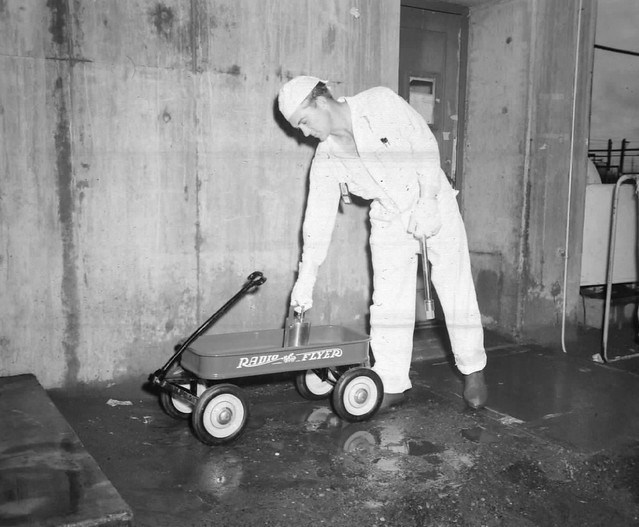
Enlargement
Accession Number N1D0036950
Document Number 12413-1-NEG-E
Alternate Document Number 12413-1-NEG
Title Description RED WAGON – CARRYING PLUTONIUM – 202-222-S
Number of Pages 1
Key Word(s) 202/222-S,HANFORD SITE,PLUTONIUM
Author(s)
Company(s)
Document Date 18-Nov-1954
Public Availability Date 14-Feb-2002
The female technician, handing over the radioactive hot pots to the guy with the sexed up chest, has even less protective gear on. No gloves and no head scarf, yet she’s handling the pots.
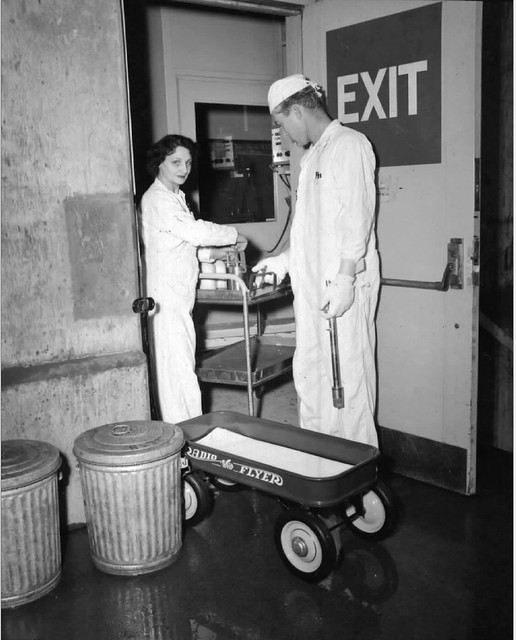
Enlargement
Accession Number N1D0036953
Document Number 12413-1-NEG
Alternate Document Number 12413-1-NEG
Title Description RED WAGON – CARRYING PLUTONIUM – 202-222-S
Number of Pages 1
Key Word(s) 202/222-S,HANFORD SITE,PLUTONIUM
Author(s)
Company(s)
Document Date 18-Nov-1954
Public Availability Date 14-Feb-2002
The above pics are from November 18, 1954. This next pic is undated but likely from the same time period. In it, we’ve slightly different attire, and a new technician, I believe, a man who’s a little heavier and older. He is wearing protective booties over his foot gear, the top of his head is covered more securely, he is buttoned up tight and perhaps his gloves are heavier duty.
Enlargement

Accession Number N1D0037355
Document Number 12535-NEG-C
Alternate Document Number 12535-NEG
Title Description LITTLE RED WAGON TRANSPORTING PLUTONIUM SAMPLES AT 202-S
Number of Pages 1
Key Word(s) 202-S,HANFORD SITE,PLUTONIUM SAMPLES TRANSPORTING
Author(s)
Company(s)
Document Date 04-Dec-2001
Public Availability Date 14-Feb-2002
We advance a month to December 17, 1954 and our photographer decides to get a little artsy, and takes pains to show the Radio Flyer logo this time, focusing on the wagon and its contents rather than the technician.
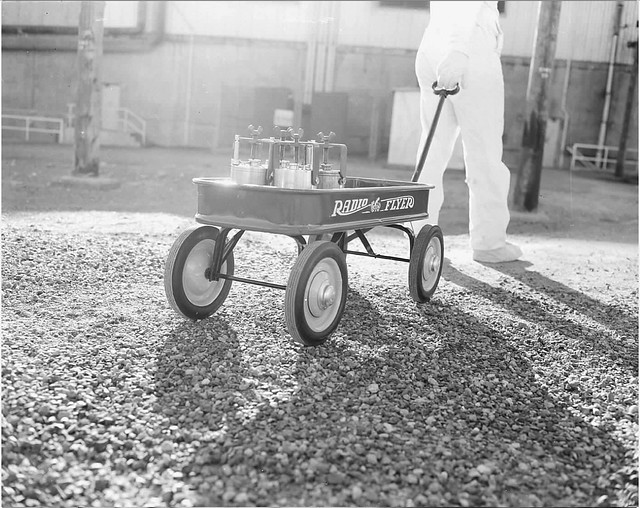
Enlargement
Accession Number N1D0037488
Document Number 12575-NEG-A
Alternate Document Number 12575-NEG
Title Description LITTLE RED WAGON – 202-S AT 200 WEST AREA
Number of Pages 1
Key Word(s) 200 WEST AREA,202-S,HANFORD SITE,LITTLE RED WAGON
Author(s)
Company(s)
Document Date 17-Dec-1954
Public Availability Date 14-Feb-2002
And another artsy no-face shot, focusing on the Radio Flyer wagon and its pots of heat.
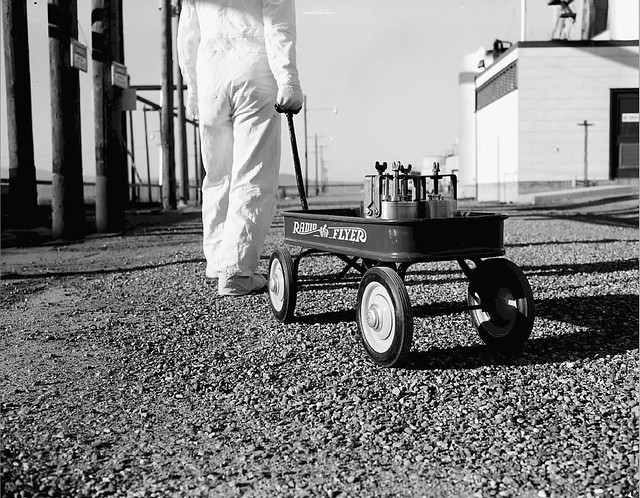
Enlargement
Accession Number N1D0037503
Document Number 12575-NEG-D
Alternate Document Number 12575-NEG
Title Description LITTLE RED WAGON – 202-S AT 200 WEST AREA
Number of Pages 1
Key Word(s) 200 WEST AREA,202-S,HANFORD SITE,LITTLE RED WAGON
Author(s)
Company(s)
Document Date 17-Dec-1954
Public Availability Date 14-Feb-2002
So, were our initial models too carelessly casual? What’s the evolution of this story, I wonder. Who came up with the idea of “Life” running the article on the toys?
Read the introduction to the Remixing the Hanford Declassified Project series of posts and digital paintings. View all digital paintings here.
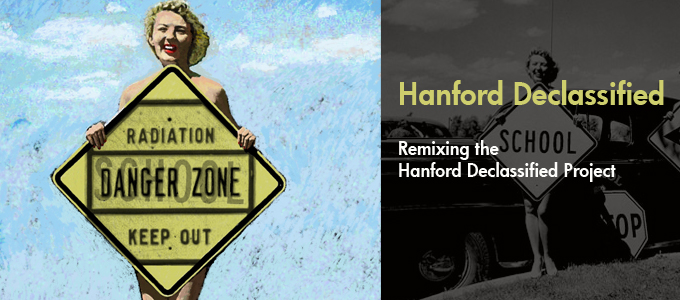
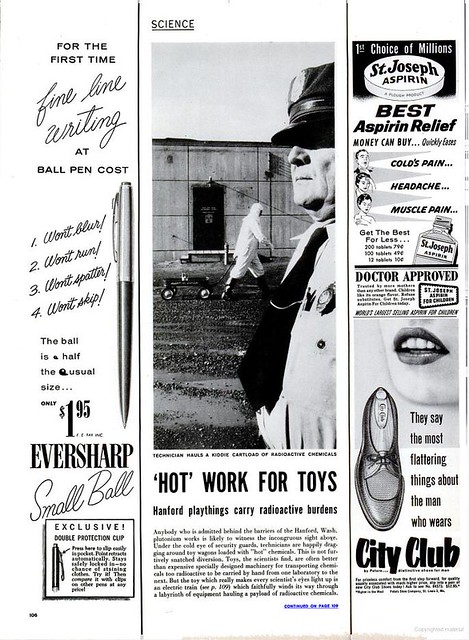
Leave a Reply to Don L Sorenson Cancel reply